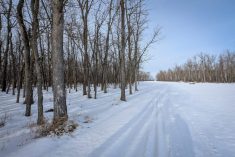The first meeting of the season for Ontario’s certified crop advisers and provincial ministry personnel north of London yielded some interesting observations for mid-April — but it’s obvious growers won’t be in the field for at least a couple of weeks.
The notion that this spring’s weather has been a stark contrast to 2012 has been overplayed in the media, and the 27 CCAs in attendance steered clear of any mention of “last year’s conditions.” Instead, the focus was on front-of-mind concerns facing growers and dealers, particularly nitrogen applications, early weed management and the possibility of switching corn hybrids or switching to soybeans from corn, should optimal planting conditions be delayed further.
Read Also

How Canada’s farmers are producing record crops despite droughts and floods
Western Canadian farmers are using minimum and zero-till farming, tile drainage, slow-release fertilizer, and better crop breeding to produce record crops despite drought conditions.
There has been some early planting, with one adviser seeing sugar beets, some sweet corn and early potatoes going in further to the southwest.
On a broader perspective, several advisers spoke of increased sales of red clover, from “up slightly” in the immediate area to nearly double in the southwest region.
As for corn planting, the focus was more on switching hybrids, and when dealers might expect to hear from their customers. One seed representative said he was expecting some of his growers to start calling within the next week, asking for advice on when to consider a switch to shorter-season hybrids. The general consensus from advisers and field staff with Ontario’s Ministry of Agriculture and Food/Ministry of Rural Affairs (MAF/MRA) was that the third week of May — around the 20th — would be the date, so there’s still plenty of time to stay with full-season hybrids.
On soybeans, the date for switching to shorter season varieties was sometime between May 7 and 10, especially if winter wheat is to be planted after harvest. Provincial soybean specialist Horst Bohner suggested growers could stick with the same variety until May 15 or even 20, without losing much yield.
One leftover from 2012 is the topic of double cropping. Provincial cereal specialist Peter Johnson noted a lot of that debate will depend on the weather. In 2012, roughly two-thirds of growers in southern Ontario with a double crop of soybeans made money on the practice, some with yields approaching 40 bushels per acre. However, Johnson said, with the spring that’s taking shape, the chances for double-cropping get smaller each day.
The issue of cover crops was also raised. In the past six months, the practice has garnered more interest among growers — some looking for an opportunity to use or sell their cover crops as a forage, others looking more for the improvement in soil health. Johnson spoke of some growers seeding oats as a cover (because sourcing is easy and seed costs are low), but cautioned against allowing the cereal to head. At that point, the crop becomes harder to plow down, and it can actually tie up more N that it provides come the spring.
On the weed management front, Johnson noted he’s seen colt’s foot in bloom and that dandelion and Canada fleabane are advancing, in spite of the slow onset of spring.
On the Canada fleabane front, Johnson said advisers need to understand that if Canada fleabane is found on in a field and if it’s resistant, then all of its offspring will be resistant. It’s of particular concern because each plant can produce up to 200,000 seeds and they’re wind-spread, much the same as dandelion seeds. In 2012, Canada fleabane was confirmed as far east as the Niagara peninsula. Johnson said the glyphosate-resistant species hasn’t been confirmed north of London into Huron-Perth and farther north, but that it’s only a matter of time, so vigilance is important.
Johnson also called attention to the advance of Palmer amaranth, a weed now confirmed in Michigan. The weed has confounded growers in the mid-U.S. South and in the last two years, moved northward into the U.S. Midwest. It migrated quickly from Arkansas and Tennessee across Indiana and Illinois, and is impervious to glyphosate. The minutes from the CCA-MAF/MRA breakfast meeting in Simcoe last Wednesday noted farmers in the southern U.S. have had to resort to manually pulling or cutting the weeds to deal with them.
— Ralph Pearce is a field editor for Country Guide at St. Marys, Ont.














